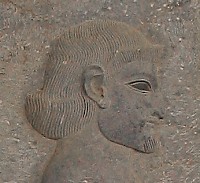Nabataea
Arabs: the people living in the country to the west and south of Mesopotamia.

Although the name "Arab" means something like "nomad", most Arabs were sedentary farmers and lived in towns. In Antiquity, their land can be divided into several zones:
- Arabia Deserta: the nomadic interior (Saudi Arabia and the desert of Syria/Iraq);
- Arabia Felix: the towns and cities in the regions bordering on the Indian Ocean (modern Yemen); the inhabitants never considered themselves Arabs;
- Nabataea in the northwest, where the people called themselves Nabataeans and had Petra as their capital.
The domestication of the dromedary allowed the Arab nomads to move over greater distances. Trade along the Incense Route from Yemen to Syria started to create some kind of homogenity. At the same time, it allowed Arab tribes to move out of their homelands. They gradually took over an urban periphery in Lebanon, Syria, and Iraq. The rise of the Umayyad Caliphate in the seventh century CE marks the final stage of this process.
Arabia Petraea or Nabataea

The Arab tribes had always been interested in the Levant. Among the oldest references to Arabs in what is now Jordan is the account of the battle of Qarqar in 853 BCE, in which the Assyrian king Salmanasser claims to have defeated a Syrian coalition. According to the Greek researcher Herodotus, the Persian king Cambyses did not subdue the Arabs when he attacked Egypt in 525 BCE. His successor Darius I the Great, however, mentions Arabs in the Behistun Inscription, which suggests that Darius conquered the northwestern part of the Arabian Peninsula.
There are no indications that these Arabs were no loyal subjects of later Persian kings. After the Macedonian king Alexander the Great had conquered the Achaemenid Empire (between 335 and 323), this part of Arabia remained more or less autonomous for centuries; it is called the Nabataean kingdom.
In 106 CE, however, the part corresponding to modern Jordan was made a province of the Roman empire by the emperor Trajan, who wanted to protect the road from Damascus to Alexandria. There were several cities in this province: from north to south Adraa (modern Dar'â), Dion, Gerasa (Jerash), Philadelphia (Amman) and Aila (Aqaba).
The Nabataeans set an example for other Arab tribes to follow. The Itureans settled in Chalcis in the Bekaa valley (eastern Lebanon). In the Parthian and Roman periods, other tribes infiltrated the urban periphery of the Syrian desert and seized power in eastern Syria (Palmyra, Emesa, Resafa), northern Iraq (Hatra), and southern Iraq (Charax).
More
For more information, see the articles on the Nabataeans and Petra.